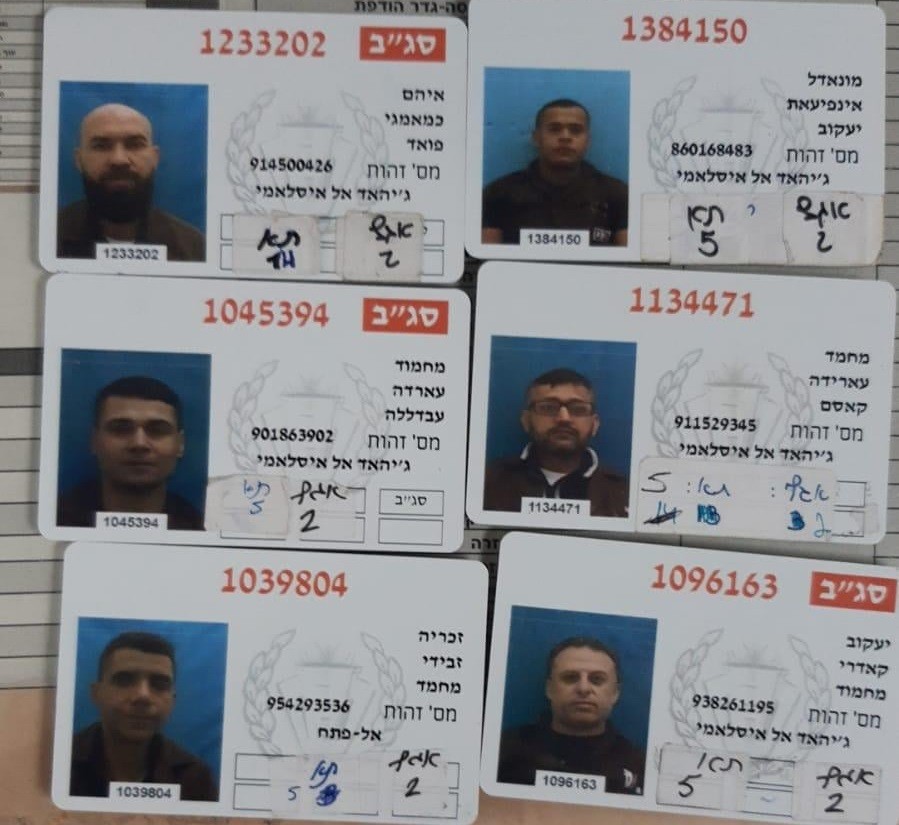Israel prison break: The six Palestinian prisoners who escaped from Gilboa prison

The escape of six Palestinian prisoners from the maximum-security Israeli prison of Gilboa has been described as “a major security and intelligence failure” by the country’s police apparatus.
On Monday, Israel’s intelligence agency Shin Bet said the six Palestinian men had coordinated with people outside the prison using a smuggled mobile phone and successfully fled the prison via a tunnel. They had an escape car waiting for them.
Arik Yaacov, Israel Prison Service's (IPS) northern commander, said the escapees appeared to have opened a hole from their cell toilet floor to access passages formed during the prison's construction.
National police spokesman Eli Levy told Kan Radio that a search is currently under way for the escapees, who are believed to be trying to reach the nearby West Bank, the Israeli-occupied territory where the Palestinian Authority exercises limited self-rule, or the Jordanian border.
Israel’s prison service said the six prisoners were serving their sentences together in Cell no. 5, Section 2 of Gilboa Prison, noting that three of them had tried to escape in the past.
New MEE newsletter: Jerusalem Dispatch
Sign up to get the latest insights and analysis on Israel-Palestine, alongside Turkey Unpacked and other MEE newsletters
Following reports of the prison break, the Palestinian Authority’s Commission for Prisoners' and Ex-Prisoners' Affairs called on rights groups and international NGOs, specifically the International Committee of the Red Cross, to immediately visit Gilboa prison and reveal the fate of more than 400 prisoners who were reportedly transferred to unknown locations after Monday's incident.
The commission warned that any retaliation against the six escapees, if captured by Israeli authorities, “may lead to a real explosion inside and outside prisons”.
"The escape stems from the Israeli injustice imposed on our male and female prisoners in the occupation’s prisons,” it added, pointing out that the prisoners are routinely subjected to life-threatening conditions in custody.
The Palestinian Prisoners' Club has published details of the six prisoners, listed below:
Zakaria Zubeidi
Zubeidi, 46, from Jenin camp, is a well-known Palestinian resistance figure. He is the former commander of the al-Aqsa Martyrs' Brigades, a military apparatus affiliated with the Fatah movement. He had been in jail since 2019 on charges of engaging in armed activities against Israel, years after agreeing to lay down his arms in 2007.
Mahmoud Abdullah Ardah
Ardah, 46, is from Jenin. He was the leader of the Gilboa prison escape operation, according to the Palestinian armed group al-Quds Brigades. He had been detained since 1996 and sentenced to life on charges of being a member of al-Quds Brigades and of involvement in the killing of Israeli soldiers. He reportedly tried to escape in 2014 from Shata prison by digging a tunnel, but his plan was unsuccessful.
Mohamed Qassem Ardah
Ardah, 39, is from Jenin. He had been detained since 2002 and sentenced to life on charges of belonging to al-Quds Brigades and of involvement in the killing of Israeli soldiers.
Yaqoub Mahmoud Qadri
Qadri, 49, is from Bir al-Basha, Jenin. He had been detained since 2003 and sentenced to life on charges of belonging to al-Quds Brigades and killing an Israeli settler. In 2014, he and a number of other prisoners, including Mahmoud Abdullah Ardah, tried to escape from Shata prison through a tunnel, but the attempt was unsuccessful.
Ayham Nayef Kamanji
Kamanji, 35, is from Kafr Dan. He had been detained since 2006 and sentenced to life on charges of killing an Israeli settler and participating in other armed activities against Israeli targets.
Munadil Yaqoub Nfeiat
Nfeiat, 26, is from Ya’bad, southwest of Jenin, and had been in jail since 2019 without charges.
Middle East Eye delivers independent and unrivalled coverage and analysis of the Middle East, North Africa and beyond. To learn more about republishing this content and the associated fees, please fill out this form. More about MEE can be found here.




